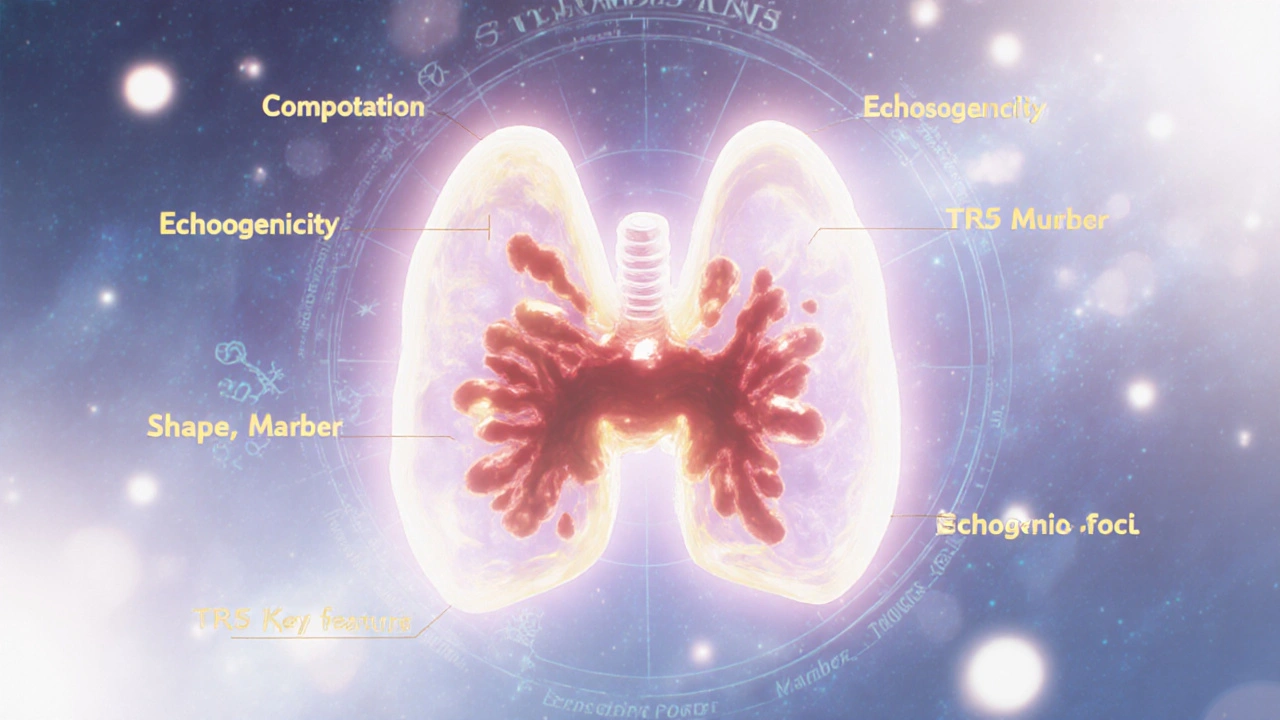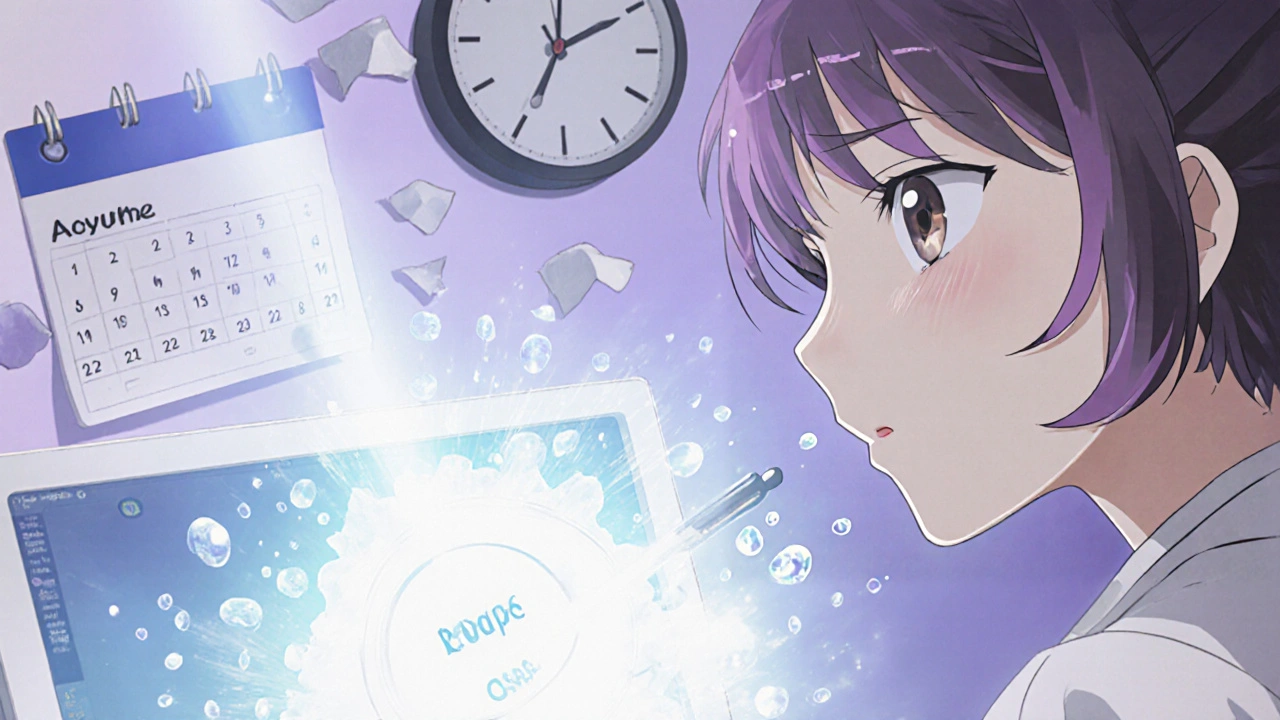
Over half of adults will develop a thyroid nodule by age 60 - but most never know it. These small lumps, often found by accident during a routine checkup or imaging for another issue, are rarely dangerous. Still, finding one raises a natural question: could this be cancer? That’s where thyroid ultrasound comes in. It’s not just a scan. It’s the most important tool doctors have to tell the difference between harmless bumps and ones that need attention.
What Thyroid Ultrasound Actually Shows
Thyroid ultrasound uses high-pitched sound waves - not radiation - to create real-time images of your thyroid gland. A small handheld device (called a transducer) is moved gently over your neck. The machine captures how sound bounces off tissues, building a detailed picture of the gland’s shape, size, and any nodules inside. Unlike physical exams, where doctors feel for lumps, ultrasound can spot nodules as small as 2-3 millimeters. Studies show it finds nodules in 19% to 68% of people - far more than any hand exam ever could. And it doesn’t just show size. It reveals texture, structure, and blood flow patterns that hint at whether a nodule might be cancerous. The scan looks at five key features:- Composition: Is the nodule mostly fluid (cystic), full of spongy tissue (spongiform), mixed, or solid? Solid nodules carry more concern.
- Echogenicity: How bright or dark does it look compared to surrounding thyroid tissue? Markedly hypoechoic (very dark) nodules are more suspicious.
- Shape: Is it wider than it is tall, or taller than wide? A taller-than-wide shape is a red flag.
- Margin: Are the edges smooth, or do they look jagged, irregular, or spreading outside the thyroid?
- Echogenic foci: Tiny bright spots inside the nodule - called microcalcifications - are one of the strongest signs of cancer.
These features aren’t judged alone. They’re combined using a system called TI-RADS - short for Thyroid Imaging Reporting and Data System. Developed by the American College of Radiology in 2017, TI-RADS turns those visual clues into a risk score.
Understanding Your TI-RADS Score
TI-RADS assigns points based on those five features. Each feature gets 0 to 3 points. The total adds up to one of five risk categories:- TR1 (0 points): 0.3% chance of cancer. Usually nothing to worry about.
- TR2 (2 points): 1.5% risk. Still very low. Often just monitored.
- TR3 (3 points): 4.8% risk. Mildly suspicious. May need follow-up or biopsy if over 1 cm.
- TR4 (4-6 points): 9.1% risk. Moderately suspicious. Biopsy is usually recommended.
- TR5 (7+ points): Up to 35% risk. Highly suspicious. Almost always requires biopsy.
For example, a solid, hypoechoic nodule with microcalcifications and irregular edges might hit 7 points - that’s TR5. It doesn’t mean you have cancer. But it means the odds are high enough that a biopsy is needed to be sure.
And here’s the key: ultrasound doesn’t diagnose cancer. It estimates risk. Only a biopsy - usually guided by the ultrasound itself - can give a final answer.
Why Ultrasound Beats Other Tests
You might wonder: why not use a CT scan, MRI, or a nuclear thyroid scan? CT and MRI are great for big structures, but they can’t see the fine details that tell cancer from benign. They often miss small nodules entirely. Nuclear scans use radiation and only show if a nodule is “hot” (overactive) or “cold” (underactive). Hot nodules are almost never cancerous. Cold ones have about a 15% risk - but that’s still guesswork. Ultrasound gives you the real picture: texture, shape, blood flow. It’s also the only test that can guide a needle precisely into a nodule during a biopsy. Without ultrasound, doctors guess where to stick the needle. With it, they see the nodule in real time. That cuts the chance of a failed or “inadequate” biopsy from 25% down to under 5%. And cost? In the U.S., it averages $200-$500 - far less than a CT or MRI. No radiation. No needles. No waiting. Results come right away.
When You Need a Biopsy - And When You Don’t
Not every nodule needs a biopsy. Size matters - but so does appearance.- Under 5 mm: Even if it looks suspicious, nodules this small are almost never dangerous. No follow-up needed.
- 5-9 mm: If it’s TR5, biopsy may be considered. If it’s TR3 or lower, just watch it with another ultrasound in 1-2 years.
- 1 cm or larger: If it’s TR4 or TR5, biopsy is standard. For TR3 nodules this size, biopsy is often done too - especially if you have other risk factors like family history of thyroid cancer.
There’s also a growing trend: active surveillance for very small, low-risk cancers. Many papillary thyroid cancers under 1 cm grow so slowly that they never cause harm. Instead of rushing into surgery, doctors now monitor them with regular ultrasounds. Studies show 10-year survival rates stay above 99% with this approach.
But if your nodule is large, growing fast, or pressing on your windpipe or voice box - even if it looks benign - surgery may still be needed.
What Happens After the Scan?
After your ultrasound, your doctor will get a report with your TI-RADS score and a description of the nodule. If the risk is low (TR1-TR2), you’ll likely just be told to come back in a year or two. No treatment needed. If it’s TR3 or higher, you may be referred for a fine-needle aspiration (FNA) biopsy. This is quick - done in the office, with local numbing. A thin needle pulls out a few cells. Those get sent to a lab. Results come in about a week. Sometimes, the biopsy comes back “indeterminate” - meaning the cells look odd, but not clearly cancerous. That happens in 15-30% of cases. In the past, this meant surgery to remove part of the thyroid. Now, molecular tests can analyze the DNA in those cells. They can tell you whether the nodule is likely benign or suspicious. This has cut unnecessary surgeries by about half. Even if molecular tests say “benign,” you still need follow-up ultrasounds. Cancer can develop later. Surveillance is part of the plan.What’s New in Thyroid Ultrasound?
Technology is getting smarter. One big leap? Artificial intelligence. A 2023 study in Nature Scientific Reports tested a deep learning system that analyzed thousands of ultrasound images. It didn’t just look at shape and texture - it also factored in the nodule’s aspect ratio (how tall vs. wide it was). The AI system reached 94.2% accuracy in spotting cancer - better than human radiologists using traditional methods (87.6%). These tools aren’t replacing doctors. They’re helping them. AI can flag subtle patterns humans might miss. It’s especially useful in places with fewer experienced radiologists. Another advance? Elastography - which measures how stiff a nodule is. Cancerous tissue tends to be harder than healthy tissue. Contrast-enhanced ultrasound, which tracks blood flow with special dyes, is also being studied. But for now, standard grayscale and Doppler ultrasound remain the gold standard.
What Can Go Wrong?
Ultrasound is reliable - but only if done right. A big problem? Inconsistent training. Studies show that radiologists need to do 200-300 supervised scans before they can accurately classify nodules with 90% agreement with experts. Many community clinics don’t have that level of experience. Another issue? Skipping the lymph nodes. Cancer can spread to lymph nodes in the neck. But audits show that 35% of routine ultrasounds don’t properly check them. That’s a missed chance to catch early spread. Equipment matters too. A machine with a 10 MHz or higher linear transducer is needed. Older machines or those without Doppler can’t capture the full picture.What to Expect During the Scan
There’s no prep. No fasting. No needles. Just lie back, neck exposed. A gel is applied to your skin - it’s cool, but not painful. The transducer glides over your neck. You might hear a soft whooshing sound - that’s the Doppler showing blood flow. The whole thing takes 15-30 minutes. You can drive home right after. No downtime. If you’re anxious, bring someone with you. Or ask the tech to explain what they’re seeing as they go. Many clinics will let you view the screen.Final Thoughts: Your Nodule Isn’t a Death Sentence
Finding a thyroid nodule is common. Finding out it’s cancer is rare. Less than 5% of all nodules turn out to be malignant. Ultrasound gives you clarity - not fear. It tells you whether to watch, biopsy, or wait. It avoids unnecessary surgery. It saves lives by catching real problems early. If your doctor recommends an ultrasound, don’t delay. It’s the single best step you can take to understand what’s going on in your neck. And if your results are low-risk? Breathe easy. You’re not alone. Most people with thyroid nodules live perfectly normal lives - no treatment needed.Can thyroid ultrasound diagnose cancer?
No. Thyroid ultrasound can’t confirm cancer. It only assesses risk by analyzing features like shape, texture, and blood flow. A biopsy - where a small sample of cells is taken - is the only way to definitively diagnose thyroid cancer. Ultrasound’s main job is to guide that biopsy accurately and decide who needs one.
Are all thyroid nodules dangerous?
No. In fact, up to 70% of adults will develop at least one thyroid nodule by age 60, and over 95% of them are benign. Most are harmless cysts or overgrowths of normal tissue. Only about 5% turn out to be cancerous. Size, appearance on ultrasound, and growth rate are better indicators of risk than the mere presence of a nodule.
What if my nodule is small but looks suspicious?
If a nodule is under 5 mm, even if it looks suspicious on ultrasound, it’s almost never a threat. Guidelines recommend no follow-up for nodules this small. For nodules between 5-9 mm with suspicious features, doctors may suggest a repeat ultrasound in 6-12 months to check for growth. Biopsy is usually reserved for nodules 1 cm or larger with high-risk features.
Do I need a biopsy if my TI-RADS score is 4?
Yes. A TI-RADS score of 4 means your nodule has a 9.1% risk of being cancerous - high enough to warrant a biopsy. This is especially true if the nodule is 1 cm or larger. Even if you feel fine, a biopsy is the next step to rule out cancer. The procedure is quick, minimally invasive, and done under ultrasound guidance for precision.
Can thyroid cancer be treated without surgery?
Yes - for very small, low-risk cancers. Many papillary thyroid cancers under 1 cm grow so slowly that they rarely cause problems. Active surveillance - regular ultrasounds every 6-12 months - is now a standard option. Surgery is only done if the nodule grows or shows signs of spreading. Studies show survival rates stay above 99% with this approach, avoiding the risks and side effects of surgery.
How often should I get a follow-up ultrasound?
It depends on your risk. For low-risk nodules (TR1-TR2), a repeat scan in 1-2 years is typical. For TR3 nodules, follow-up in 6-12 months is common. If you’ve had a benign biopsy, you’ll usually get an ultrasound every year for 2-5 years to make sure nothing changes. If your nodule is stable over time, the intervals can be stretched out.
harenee hanapi
November 20, 2025 AT 20:36This is why I hate American medicine-everything’s a scam. They scare you with ‘nodules’ and then charge you $500 to tell you you’re fine. I got one last year, skipped the scan, and I’m still alive. 🤷♀️
Christopher Robinson
November 21, 2025 AT 13:49Love how this breaks it down without the fear-mongering. 😊 Honestly, if you’ve got a TR1 or TR2, just chill. I’ve got three nodules and my doc said ‘come back in 2 years unless you start choking.’ I’m living my best life. 🙌
James Ó Nuanáin
November 21, 2025 AT 16:34It is a matter of profound concern that the United Kingdom, despite its superior healthcare infrastructure, has not adopted TI-RADS with the same rigour as the United States. Our NHS still relies on antiquated palpation methods in some regions. This is not merely inefficiency-it is negligence. 🇬🇧🇺🇸
Nick Lesieur
November 23, 2025 AT 14:32so like... if u got a nodule and u dont wanna pay 500 bucks, just ignore it? lol. my aunt had one for 10 yrs and she's fine. also, who the hell says 'echogenic foci' like its a magic spell? 🤭
Angela Gutschwager
November 24, 2025 AT 16:16Ultrasound is free at my clinic. Just show up. No referral needed.
Also, AI is great-but only if the tech isn’t asleep during the scan.
Andy Feltus
November 26, 2025 AT 08:18Think about it: we’ve turned a biological quirk into a medical crisis. 70% of people have these. Most never know. But now we scan, classify, biopsy, stress, and surgically remove-just to be ‘safe.’
What if the real cancer is the system that convinced us we’re all dying? 🤔
Dion Hetemi
November 26, 2025 AT 11:49Let’s be real-most of these ‘low-risk’ nodules are just the result of decades of processed food, fluoride, and stress. No one talks about the real causes. You want to reduce cancer risk? Stop eating microwave popcorn and start breathing. 🤬
Kara Binning
November 27, 2025 AT 06:08I’m a nurse in Ohio. We had a 22-year-old come in with a TR5 nodule. She cried because she thought she was going to die. We did the biopsy-it was benign. She hugged me.
That’s why this matters. Not because of the numbers-but because people are scared. And we need to hold their hands through it.
river weiss
November 27, 2025 AT 17:54It’s worth noting that TI-RADS is not universally applied-even in academic centers. Variability in interpretation remains a significant concern.
Furthermore, the 2023 AI study referenced had a narrow dataset; external validation across diverse populations is still pending.
Always consult with a board-certified endocrinologist, and request a second opinion if your TI-RADS score is 4 or higher.
Also: hydration improves tissue contrast on ultrasound. Drink water before your scan.
Brian Rono
November 29, 2025 AT 10:36Oh, so now we’re using AI to diagnose cancer instead of just letting doctors use their brains? Next they’ll replace surgeons with ChatGPT. ‘Hey bot, what’s the best way to cut out a thyroid?’ ‘Well, according to my training data, 73% of patients prefer the left incision.’ 🤖
seamus moginie
November 30, 2025 AT 02:06Back in Dublin, we used to just wait and see. Now we’re scanning everyone like they’re walking time bombs. I had a nodule at 35. Doc said ‘watch it.’ I did. It vanished. No biopsy. No drama. Just life.
Timothy Reed
December 1, 2025 AT 17:10Thank you for this clear, evidence-based breakdown. Many patients are overwhelmed by jargon and fear. This helps them understand that ‘suspicious’ doesn’t mean ‘cancer.’
It’s also important to remember that even TR5 nodules have a 65% chance of being benign. That’s not a death sentence-it’s a call to action with clarity.
Dana Dolan
December 3, 2025 AT 10:43My mom had a TR3 nodule. They did the biopsy. Turned out to be Hashimoto’s. She didn’t need surgery-just levothyroxine.
But if they hadn’t scanned it, she’d still be tired, gaining weight, and blaming ‘getting older.’
So yeah-get the scan. Even if you’re scared.